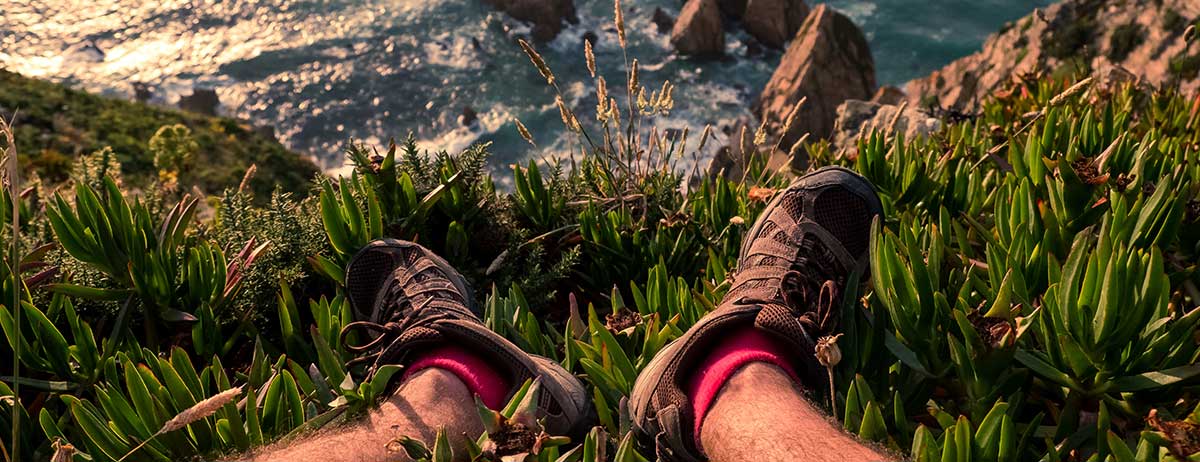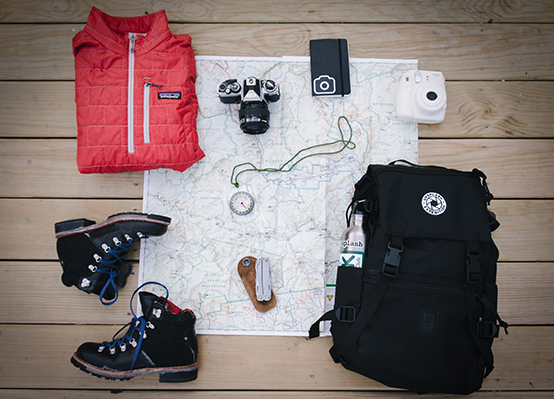
When using Sherpa Van to transport your luggage on your walking or cycling trip, you obviously only need to carry the essentials with you when you’re out on the trail. But what are those essentials?
Here we take a look at the kit you need to have in your bag when you’re out walking.

Take comfortable, broken-in, but not broken-down hiking boots with some cushioning either in the insole, outsole or both. Trail or fell runners may be used to tackling alpine paths in trail shoes, but for most walkers, trainers or running shoes do not give enough support for the rocky, uneven terrain. Hiking boots come in different categories of stiffness (based on the difficulty of the terrain for which the shoes are designed). On particularly stony trails such as the James Herriot Way, a pair of short gaiters called ankle gaiters, can be fitted to stop your boots filling up with stones.
Wear a hat to protect your face and head from the sun, or to keep your head warm in chilly weather. Some have flaps to protect your ears and neck as well. The best hats are the ones that not only dry fast but retain their shape once you have stuffed them in your bag.
Take along suitable sunglasses - they should be wrap-round style and rated Category 3. For those of you that plan to go particularly high or into snow then 'Category 4' and, preferably, a pair with side protection is recommended.
Always remember to take a rainproof top and trousers. The UK weather, especially in the north, can be very unpredictable, and you do not want to be caught out in the wet. It’s amazing how many people replace Gore-tex and other 'breathable' garments because they think that they no longer breathe. It is usually the case however that the garment is fine, but the fabric works on a humidity gradient and sweat will always build up in conditions where you work yourself hard, so they may just need a good clean.
Wear thick socks, preferably loop stitched and seamless ones. This can prevent your feet from getting blisters and adds cushioning to your walk. Tip of the expert: carry a spare pair with you.
GPS is generally accurate and reliable, however when it goes wrong it’s great to have the back-up of a real map and compass. Although high-end GPS and some phones have good mapping features, it is often difficult to view the LCDs in bright sunlight and also to see 'the big picture'. Don't forget a waterproof map case to protect your maps from the rain.
Take a whistle to warn people in the area if you’re in trouble. The emergency signal to use if you need help is 6 signals per minute followed by a one-minute break. You should repeat this until help arrives or until you get an answer of 3 signals per minute followed by a one-minute break. In case you don't have a whistle, you can use a torch (flashlight).
Put all these items in a comfortable day pack - there are many makes at so many different prices. You will be generally better off having a bag that is a bit bigger than all that you put into it, to avoid crushing items. So if you know that your 30 litre pack is crammed full, get a 45 or 50 litre one. Bags with a chest harness as well as waist harness give better stability while you are walking or moving downhill. If you like your photography and plan on carrying your camera, then you should have enough room to stow it during bad weather.
Very few makes of rucksack are completely waterproof, and during a big shower some water can penetrate even if you have a rain cover. So, a dry bag for delicate items such as first aid kit, camera, passport etc, are really useful.
First aid kit, including a rescue or Bivouac bag or blanket, in case you have to stop in an emergency.
Mobile phone with important phone numbers at hand, even though remote areas may have no mobile coverage, there may be others near you with satellite phones.
Trekking poles are convenient for both descending and ascending as well they are indispensable on difficult terrain. Poles can be used to pre-load your weight as you descend and save pressure on the knees.
Sufficient amount of food and drinks: a water bottle with at least 1-litre capacity - normally there are plenty of places to fill up in the mountains to avoid dehydration. Also bring with you some spare food such as energy bars, nuts, dried fruit etc.
If you wear shorts, don’t forget to also pack a lightweight pair of long trousers to protect against the sun, cold and insects. Trousers are also useful when walking through thicker vegetation. Trousers with zips around the legs that turn into shorts can be useful if you prefer not to carry an extra pair.